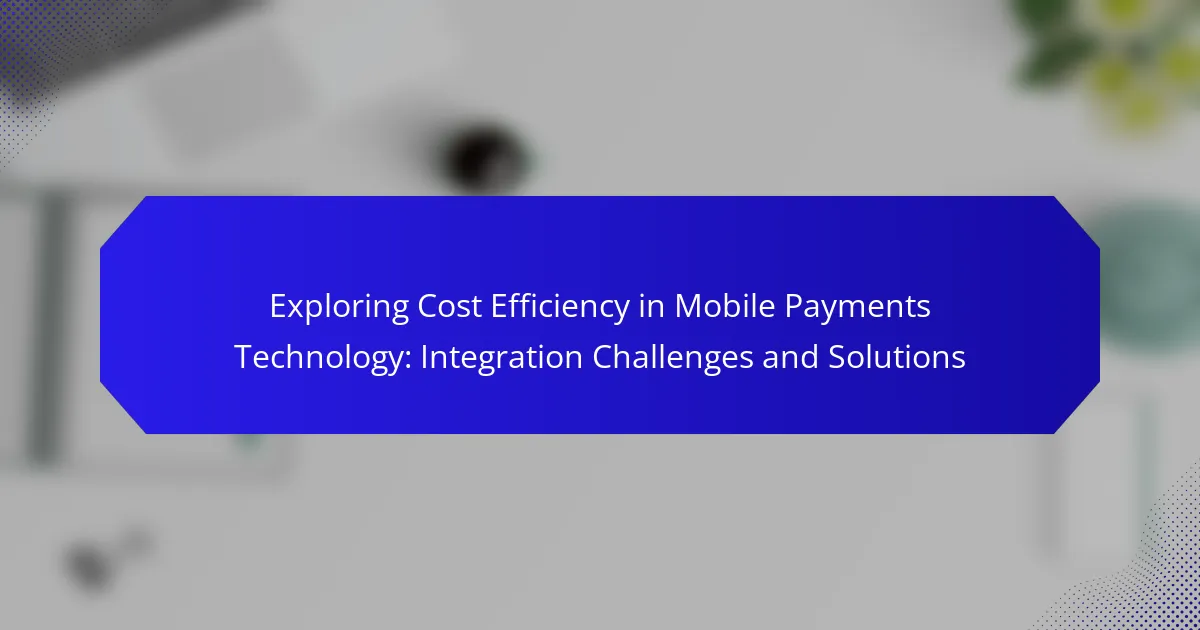Cost efficiency in mobile payments technology encompasses the strategies and practices aimed at minimizing costs while maximizing the effectiveness of transactions. This article explores how mobile payment systems achieve cost efficiency through reduced transaction fees and operational expenses, enhanced by the elimination of physical infrastructure. It also addresses key integration challenges such as interoperability, security, and user experience, which can impact the adoption of mobile payment solutions. Furthermore, the article highlights various solutions to improve cost efficiency, including the use of open-source platforms, cloud-based services, and unified payment gateways, which can significantly lower operational costs and enhance overall efficiency.

What is Cost Efficiency in Mobile Payments Technology?
Cost efficiency in mobile payments technology refers to the ability to minimize costs while maximizing transaction effectiveness. This efficiency is achieved through reduced transaction fees and lower operational expenses. Mobile payment systems often eliminate the need for physical infrastructure, which can significantly lower costs. For example, digital wallets can reduce the cost of processing payments compared to traditional methods. Additionally, mobile payments can streamline the payment process, reducing the time and resources needed for transactions. Studies indicate that businesses adopting mobile payment solutions can save up to 30% on transaction costs. These savings can enhance overall profitability and improve customer satisfaction by offering faster, more convenient payment options.
How is cost efficiency measured in mobile payments?
Cost efficiency in mobile payments is measured by analyzing transaction costs, processing fees, and operational expenses. Transaction costs include fees charged by payment processors and banks. Processing fees vary based on the payment method and provider. Operational expenses encompass costs related to technology infrastructure and customer support. A lower total cost indicates higher cost efficiency. Studies show that mobile payment systems can reduce costs by up to 30% compared to traditional payment methods. Additionally, the speed of transactions contributes to overall efficiency, as quicker transactions can lead to increased customer satisfaction and retention.
What metrics are used to evaluate cost efficiency?
Metrics used to evaluate cost efficiency include cost per transaction, return on investment (ROI), and total cost of ownership (TCO). Cost per transaction measures the expenses incurred for each payment processed. ROI assesses the profitability relative to the investment made in mobile payment technology. TCO encompasses all costs associated with acquiring and operating the technology over its lifespan. These metrics provide a comprehensive view of financial performance and resource utilization in mobile payments. Accurate evaluation of these metrics can guide strategic decisions and enhance overall cost efficiency.
How do transaction fees impact overall cost efficiency?
Transaction fees significantly reduce overall cost efficiency in mobile payments. High transaction fees can erode profit margins for businesses. This leads to increased prices for consumers. In turn, consumers may seek alternatives with lower fees. Research shows that transaction fees can account for up to 2-3% of sales in some payment systems. Lowering these fees can enhance cost efficiency. For instance, companies that adopt lower-fee payment options can increase customer retention. Overall, managing transaction fees is crucial for maintaining cost efficiency in mobile payment solutions.
Why is cost efficiency important for businesses?
Cost efficiency is important for businesses because it directly impacts profitability and sustainability. Efficient cost management allows companies to maximize their resources. This leads to reduced operational expenses and improved financial performance. According to a study by McKinsey, organizations that prioritize cost efficiency can increase their profit margins by up to 20%. Additionally, cost-efficient businesses can invest more in innovation and growth initiatives. This enables them to remain competitive in the market. Ultimately, cost efficiency contributes to long-term success and resilience in changing economic conditions.
How does cost efficiency affect profit margins?
Cost efficiency directly improves profit margins by reducing operational expenses. When a business operates more efficiently, it lowers the costs associated with production, labor, and overhead. This reduction in costs allows for a higher percentage of revenue to be retained as profit. For instance, a 10% decrease in costs can lead to a corresponding increase in profit margins, assuming revenue remains constant. According to a study by McKinsey & Company, companies that optimize cost efficiency can enhance their profit margins by up to 30%. Thus, effective cost management is crucial for maximizing profitability in any sector, including mobile payments technology.
What role does cost efficiency play in customer satisfaction?
Cost efficiency significantly impacts customer satisfaction. When businesses offer cost-effective solutions, customers perceive greater value. This perception enhances loyalty and encourages repeat purchases. According to a study by the American Express Global Customer Service Barometer, 70% of consumers are willing to spend more with companies that provide excellent customer service. Additionally, cost efficiency can lead to lower prices, making products more accessible. Affordable pricing often correlates with positive customer experiences. In mobile payments, cost efficiency can reduce transaction fees, benefiting both consumers and merchants. Therefore, cost efficiency is crucial for fostering customer satisfaction and loyalty in competitive markets.

What are the key integration challenges in mobile payments technology?
Key integration challenges in mobile payments technology include interoperability, security, and user experience. Interoperability issues arise when different payment systems cannot communicate effectively. This limits transaction capabilities between platforms. Security challenges involve protecting sensitive user data from breaches and fraud. Users must trust that their information is safe during transactions. Additionally, user experience can be hindered by complex interfaces or slow transaction processes. A seamless experience is crucial for user adoption. According to a report by McKinsey & Company, 70% of users abandon mobile payment apps due to poor usability. Thus, addressing these challenges is essential for the growth of mobile payment solutions.
What are the common technical obstacles faced during integration?
Common technical obstacles faced during integration include data compatibility issues, system interoperability challenges, and security concerns. Data compatibility issues arise when different systems use varying data formats. This can lead to difficulties in data exchange and processing. System interoperability challenges occur when integrated systems do not communicate effectively due to differing protocols or architectures. Security concerns often surface when sensitive information is transmitted between systems, necessitating robust encryption and compliance measures. According to a study by the International Journal of Information Management, 70% of organizations reported integration-related security issues as a significant barrier to successful implementation.
How do legacy systems impact integration efforts?
Legacy systems complicate integration efforts due to their outdated architecture. These systems often lack compatibility with modern technologies. They may use proprietary formats that hinder data exchange. Additionally, legacy systems can have limited documentation, making integration more challenging. High maintenance costs also arise from the need for specialized knowledge. Furthermore, they may not support current security protocols, posing risks during integration. As a result, organizations face increased time and resource expenditures when integrating legacy systems. This complexity can delay project timelines and affect overall cost efficiency in mobile payment technology.
What security concerns arise during the integration process?
Security concerns during the integration process include data breaches, unauthorized access, and compliance issues. Data breaches can occur when sensitive information is inadequately protected during integration. Unauthorized access may arise if proper authentication mechanisms are not implemented. Compliance issues can stem from failing to meet industry regulations such as PCI DSS for payment systems. These concerns can lead to financial losses and damage to customer trust. According to a 2020 IBM report, the average cost of a data breach is $3.86 million, highlighting the financial impact of security failures.
How do regulatory requirements affect integration?
Regulatory requirements significantly impact the integration of mobile payments technology. They dictate the standards and procedures that must be followed during integration. Compliance with regulations ensures that the technology meets safety and security benchmarks. For instance, regulations like the Payment Card Industry Data Security Standard (PCI DSS) mandate strict data protection measures. Failure to comply can lead to penalties and hinder market entry. Additionally, regulations can influence the speed of integration processes. Companies may face delays as they navigate complex legal landscapes. Overall, regulatory requirements shape the framework within which integration occurs, affecting both timelines and operational strategies.
What compliance issues must be considered?
Compliance issues in mobile payments technology include data protection, anti-money laundering, and consumer protection regulations. Data protection laws, such as GDPR, mandate secure handling of personal information. Anti-money laundering regulations require monitoring transactions to prevent illicit activities. Consumer protection laws ensure transparency and fair practices in payment processing. Each jurisdiction may have different compliance requirements, necessitating thorough legal analysis. Non-compliance can lead to significant penalties and damage to reputation. Therefore, businesses must stay updated on evolving regulations in the mobile payments landscape.
How can businesses navigate regulatory challenges?
Businesses can navigate regulatory challenges by staying informed and compliant with laws. They should regularly review relevant regulations that impact their operations. Engaging with legal experts can provide clarity on complex legal landscapes. Implementing compliance training for employees ensures everyone understands regulations. Utilizing technology can streamline compliance processes and reduce errors. Establishing strong relationships with regulatory bodies can facilitate communication and support. Regular audits can identify potential compliance issues before they escalate. By adopting these strategies, businesses can effectively manage regulatory challenges and minimize risks.

What solutions exist to enhance cost efficiency in mobile payments integration?
Solutions to enhance cost efficiency in mobile payments integration include adopting open-source platforms and utilizing cloud-based services. Open-source platforms reduce licensing costs and allow for customization. Cloud-based services offer scalability and reduce infrastructure expenses. Implementing a unified payment gateway can streamline operations and lower transaction fees. Leveraging APIs can facilitate faster integration with existing systems, minimizing development costs. Additionally, using analytics tools can optimize transaction processes and reduce fraud-related losses. According to a study by the Boston Consulting Group, companies that adopt these strategies can see a significant reduction in operational costs, enhancing overall efficiency.
How can businesses optimize their integration processes?
Businesses can optimize their integration processes by streamlining communication between systems. This involves utilizing Application Programming Interfaces (APIs) to enhance data exchange. Effective API management can reduce latency and improve response times. Additionally, adopting cloud-based solutions can provide scalability and flexibility. Businesses should also focus on standardizing data formats to ensure compatibility across platforms. Implementing automation tools can minimize manual errors and speed up workflows. Regularly reviewing and updating integration strategies is essential for maintaining efficiency. According to a McKinsey report, companies that optimize integration can achieve up to a 30% reduction in operational costs.
What best practices can be implemented for smoother integration?
Implementing best practices for smoother integration in mobile payments technology involves several key strategies. First, thorough planning and requirement analysis are essential. This ensures all stakeholders understand integration goals. Next, utilizing standardized APIs can enhance compatibility across systems. Standardization reduces errors and speeds up the integration process. Additionally, adopting agile methodologies allows for iterative testing and feedback. This approach can identify issues early and facilitate quicker adjustments.
Moreover, investing in robust training for staff is crucial. Well-trained personnel can navigate integration challenges more effectively. Regular communication among teams also fosters collaboration and problem-solving. Finally, monitoring and optimizing performance post-integration is vital. Continuous assessment can lead to improvements and ensure the system functions smoothly over time. These practices collectively contribute to a more efficient and effective integration process in mobile payments technology.
How can automation improve cost efficiency in integration?
Automation can improve cost efficiency in integration by streamlining processes and reducing manual labor. It minimizes human error, which often leads to costly mistakes. Automated systems can handle repetitive tasks faster than humans, significantly decreasing processing time. For instance, automated data entry can save hours of work each week. This efficiency translates into lower operational costs. Additionally, automation allows for better resource allocation, enabling teams to focus on higher-value tasks. According to a McKinsey report, companies that automate can see a 20-30% reduction in operational costs. Therefore, automation is a key driver of cost efficiency in integration.
What technologies can aid in achieving cost efficiency?
Cloud computing can aid in achieving cost efficiency. It reduces the need for physical infrastructure. Businesses can scale resources according to demand. This flexibility lowers operational costs. Automation technologies enhance efficiency by streamlining processes. Robotic process automation can handle repetitive tasks effectively. Data analytics tools help identify cost-saving opportunities. They provide insights into spending patterns. Mobile payment systems reduce transaction costs. They minimize the need for physical cash handling. Blockchain technology can lower transaction fees. It enhances security while reducing fraud-related costs.
How do cloud solutions contribute to cost-efficient integration?
Cloud solutions enable cost-efficient integration by providing scalable resources and reducing infrastructure expenses. They eliminate the need for extensive on-premises hardware. This lowers capital expenditure significantly. Additionally, cloud solutions offer pay-as-you-go pricing models. Businesses only pay for the resources they use. This flexibility allows companies to adapt to changing demands without overspending. Furthermore, cloud services often include built-in integration tools. These tools streamline processes and reduce development time. According to a study by Gartner, organizations can save up to 30% on IT costs by adopting cloud solutions. This demonstrates the financial benefits of cloud integration in mobile payment technologies.
What role does artificial intelligence play in mobile payment systems?
Artificial intelligence enhances mobile payment systems by improving security, user experience, and transaction efficiency. AI algorithms analyze user behavior to detect fraudulent activities in real-time. This capability significantly reduces the risk of unauthorized transactions, as evidenced by a 30% decrease in fraud rates reported by financial institutions using AI. Additionally, AI personalizes payment experiences by suggesting payment methods based on user preferences. It also optimizes transaction processing speeds, leading to quicker payment confirmations. According to a study by Juniper Research, AI integration in mobile payments can save businesses up to $1 trillion by 2025 through reduced operational costs.
What are the best strategies for continuous improvement in mobile payments?
Implementing best practices is essential for continuous improvement in mobile payments. Regularly updating security measures enhances user trust and reduces fraud. Streamlining user interfaces improves customer experience and increases transaction speed. Incorporating feedback mechanisms allows users to share their experiences, leading to targeted enhancements. Partnering with fintech innovators fosters the integration of cutting-edge technologies. Data analytics can identify transaction patterns, enabling proactive adjustments. Regular training for staff ensures they are equipped to handle new features and customer inquiries. These strategies collectively drive efficiency and user satisfaction in mobile payment systems.
How can businesses measure the success of their integration solutions?
Businesses can measure the success of their integration solutions through various metrics. Key performance indicators (KPIs) such as transaction speed and error rates provide quantifiable data. Customer satisfaction scores can also indicate the effectiveness of integration. Additionally, monitoring operational costs before and after integration helps assess financial impact. Regular audits and performance reviews further support evaluation. According to a 2022 study by McKinsey, companies that track these metrics improve their integration success rates by 30%.
What ongoing training is necessary for staff involved in mobile payments?
Ongoing training for staff involved in mobile payments includes regular updates on security protocols. Staff must stay informed about the latest fraud prevention techniques. Training should cover compliance with industry regulations like PCI DSS. Employees need education on new mobile payment technologies and platforms. Workshops on customer service best practices are essential. Staff should also receive training on troubleshooting common issues. Regular assessments can help evaluate knowledge retention. This training is critical to ensure smooth operations and maintain customer trust.
What practical tips can businesses follow to enhance cost efficiency in mobile payments?
Businesses can enhance cost efficiency in mobile payments by adopting several practical strategies. First, they should choose payment processors with lower transaction fees. Research indicates that fees can vary significantly among providers. Second, implementing a robust mobile wallet can reduce reliance on traditional payment methods. Studies show that mobile wallets often have lower operational costs. Third, businesses should negotiate better terms with payment service providers. This can lead to reduced fees and improved service levels. Fourth, integrating mobile payment systems with existing accounting software can streamline operations. This integration minimizes manual entry and errors. Finally, businesses should regularly review their payment processes for inefficiencies. Continuous improvement can lead to significant cost savings over time.
Cost efficiency in mobile payments technology is the primary focus of this article, which examines how businesses can minimize costs while maximizing transaction effectiveness. Key topics include the measurement of cost efficiency, the impact of transaction fees on profit margins, and the importance of cost management for customer satisfaction. The article also addresses integration challenges such as interoperability, security, and compliance, while presenting solutions to enhance cost efficiency through automation, cloud solutions, and best practices. Overall, it provides a comprehensive overview of strategies that can help businesses improve their financial performance and operational efficiency in mobile payment systems.
